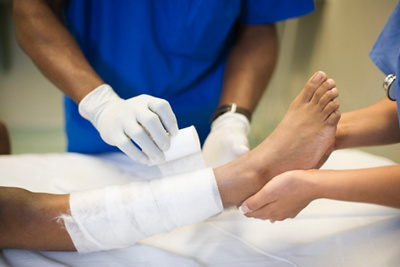In rural areas of South Africa, where most people cook on fires, electric hot plates, and paraffin (kerosene) stoves, accidents are common. Worse still is that misinformation about preventing and treating burns is widespread.
Applying butter on a burn is dangerous, but this practice persists in rural South Africa, says ER24 ALS Dakalo Tshiwawa. She witnessed this first-hand when her younger brother suffered burns in a cooking-fire accident 17 years ago.
“It was in 2007, around 8pm on a cold evening in Limpopo when my grandmother had just finished cooking on the fire,” Tshiwawa recalls. “She then put a pot of water on the fire to boil for us to bathe with, and my brother and sister were fighting about who was going to sit on my lap by the fire.”
During the scuffle one of her siblings accidentally knocked over the kettle, spilling boiling water in a pool on the ground. “We all turned to run, but my brother, who was about six years old at the time, fell into the boiling water, burning his body.”
Using butter to treat burns is dangerous
It was in the shocking moments after her brother fell into the boiling water that neighbours advised Tshiwawa’s grandmother to apply butter to the wounds. This theory comes from the mistaken belief that butter can promote faster healing. Tshiwawa learned that day that it was a bad theory. This is because butter does nothing to soothe burns. Even worse, because it is oil-based, it aggravates the wounds when mixed with the heat from the burn.
Her brother suffered third-degree burns on his chest and abdomen. Although the provincial ambulance service took a while to arrive, things could have been worse had emergency help not been available at all.
Inspiration from a traumatic situation
Watching the medics at work, Tshiwawa was in awe of how they handled her brother, and how friendly they were when explaining their procedures to the family. This was just one of the things that inspired her to pursue a career in EMS. She also used her training to educate her rural community about burn awareness and other emergencies and to bring an EMS service closer to home.
Much has changed since that traumatic day in 2007: There is a 24-hour clinic just three doors away from her family’s home in Limpopo, and emergency medical services are closer and quicker to respond. She now works in Vanderbijlpark, Gauteng, where she lives with her husband and daughter.
Burn survivor
Although he hardly remembers anything about the incident, Tshiwawa’s brother bears evidence of it through scars on his body and hearing eye-witness accounts. He’s learned to accept and embrace the scars, Tshiwawa says, and is now studying business management with ambitions of starting his own business.
The only thing that hasn’t changed is that local people still cook on fires despite now owning electric stoves, says Tshiwawa. “People in Limpopo grew up cooking on fires. They also say the food tastes better, so they prefer cooking that way,” she explains. "That’s why education about prevention and treatment of burns is so important.”
What to do in a burn incident: Tshiwawa’s advice
- Remove the person from the source of the burn when safe to do so.
- Don’t apply butter – it worsens the burn when in contact with hot skin. Applying other substances like cold milk, toothpaste, alcohol, or vinegar, is also dangerous.
- Remove clothing – some chemicals in clothing fabrics can also aggravate the burns.
- Cool down the burned area using cool water – don’t apply ice or ice water, as it does more damage to the skin.
- Cover the burned area with ointment – use something sterile to do this. I find Burnshield dressing to be most effective, as it also helps to cool and soothe the burn. Keep some in your home/travel first aid kit.
- Use cling wrap – once the sterile ointment is applied, cover the burnt area with cling wrap to keep it moist.
- Call the ER24 Contact Centre on 084 124 – a trained agent will talk you through the procedure of dealing with a burn victim.


